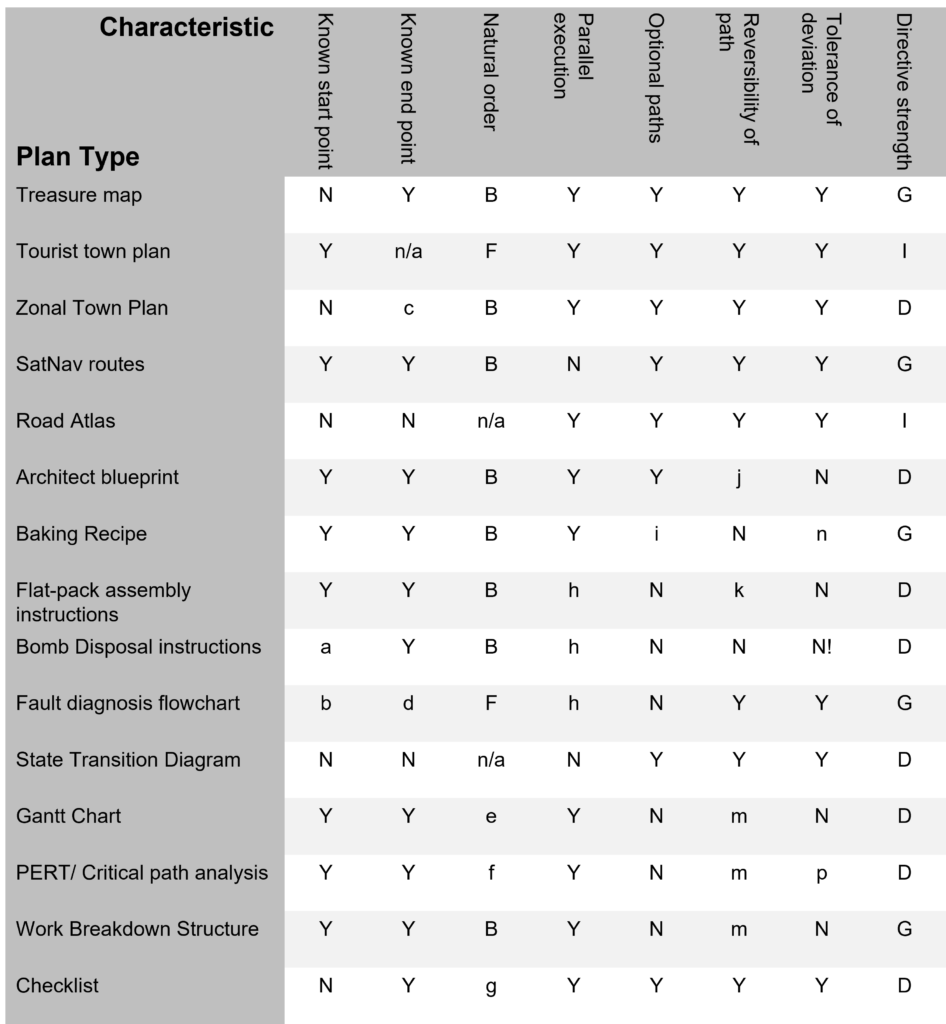In another section we considered different horizons of uncertainty that drive different approaches to the planning process. Here we consider different forms of resultant plan. There are lots of things that can legitimately be called a plan. There is huge risk of equivocation when someone says ‘we need a plan’ – they might mean any one of many very different things. When we agree that we need a plan we may have something radically different in mind. It is helpful to be aware of some of the different kinds of plan that might be created, even more so the different characteristics of these plans. But the primary factor in picking the most suitable form of plan is fitness for purpose.
The different types of plan can be distinguished by different sets of characteristics:
Start point: known or unknown
Finish point(s): Known or unknown
Natural Direction for creating the plan: Some naturally are developed from where you are. Some start from where you want to be and work back. Some do either, both or none in particular.
Parallel execution: A plan may comprise different aspects that can be executed in parallel (typically by different sub-teams), or be constrained to a single linear path.
Path optionality: Is there a single best path, or are there multiple valid paths depending on secondary preferences?
Reversibility of execution: Can a plan be undone or retraced? SatNav guidance can be retraced for a modest cost of fuel. When following a recipe its impossible to unscramble an egg.
Tolerance of deviation: Is the path broad? Are detours acceptable, or is this more of a tight-rope walk where one must not put a foot wrong?
Directive strength: What is the intent of the creator of the plan? To provide an example that the implementer is free to take or ignore? (Illustrative) ) Or is it Normative – with the expectation that the plan is there to be followed? Or Directive – with the threat of sanction if not followed.
The typical characteristics of the plan types listed above are summarised in the table below:

Legend:
- Y= Yes
- N= No
- B= Backwards- the plan is developed based on starting with where we want to end up and working backwards to where we are.
- F= Forwards- starting from where we are and identifying a sequence steps that take us forward (destination may not even be known until the plan is developed)
- n/a= not applicable
- D= Directive
- I= Illustrative
- G = Normative (Guideline)
- a: first task may be to determine what state the bomb is in and therefore where we need to start
- b: there may be multiple start points into a diagnostic process
- c: There may be a ‘known endpoint’ of activities in each zone conforming to the desired pattern
- d: “Problem fixed” may be a known target, but typically there are other possible outcomes for this process (for example, “call engineer” or “replace part”)
- e: In my experience these are usually ‘right to left’ (what needs to be done to get to where we want to be) but they can be here-out (what do we do next and then what after that?). There is often a bit of a mix, but right-to-left tends to dominate.
- f: Critical Path Analysis typically has a known start and end points and the optimal path is determined with a mix of forward and backward perspectives.
- g: Checklists are typically initiated as a result of failures, hence backward. But then the design of the initial checklist is often forward. Improvements over time tend to be backward (reacting to more undesired outcomes).
- h: Parallel execution tends not to work well. An example of ‘too many cooks spoil the broth’.
- i: Most cooking recipes are tolerant to variations
- j: Reversing work on a building site can be expensive. Un-pouring concrete is not possible. Especially when set.
- k: Most flat pack assembly can be reversed (thankfully) to cover for errors and future house-moving. But some actions (gluing and some push-fits) are irreversible (cause damage if reversal is attempted).
- m: Reversibility of project plans depends on nature of work conducted. Usually some aspect is irreversible, even if only cost of labour.
- n: Curries are pretty tolerant. Souffle and Chocolate Fondant much less so. Anything toffee related is tolerant with regard to being edible, but intolerant when it comes to having the texture and physical properties planned (else caramel becomes fudge and vice-versa).
- p: tolerance depends on the nature of the plan and degree of optimisation (see Russian Moon Landings).
Different types of plan
- Treasure Map – X marks the spot
- Tourist Town Plan – You are here
- Town Zonal Planning – residential/ light industry/ retail/ leisure etc.
- SatNav- routes and directions, typically offering 3 choices
- Road Atlas
- Architect Blueprint
- Recipe – making a cake
- Assembly Instructions – flat pack furniture
- Bomb Disposal Instructions
- Flowchart – eg diagnosing a fault with a boiler
- State Transition Diagram – (also called a State Diagram) describing operations of a complex system
- Project Plan – Gantt chart or Sunray diagram[1]
- PERT chart/ Critical Path Analysis
- Checklist – especially for risk reduction (eg in hospital operations). A list of things to ensure are completed or otherwise correct.
There are many other plan types and yet more characteristics but these lists suffice to show that “we need a plan” (without further definition and clarification) is itself a plan for disaster.
[1] The equivalence and differences between Gantt Chart and forms of SunRay diagram are considered in another page.